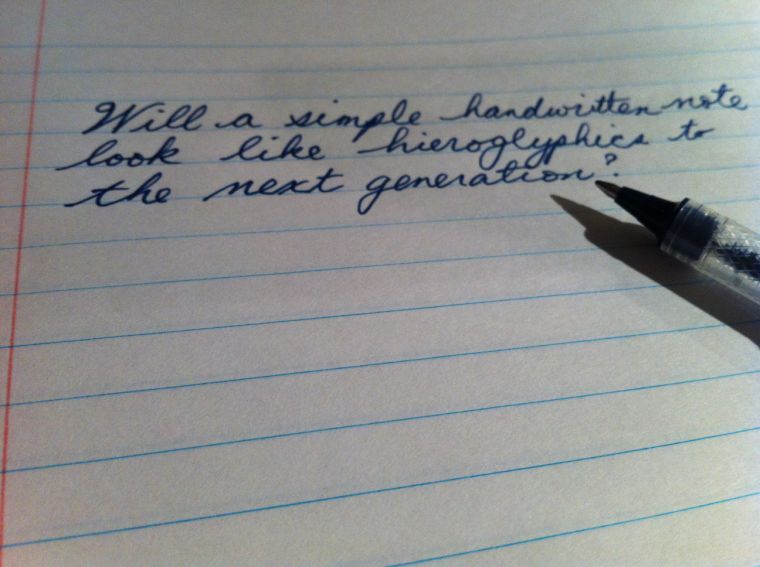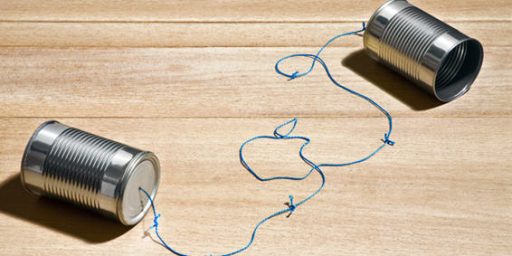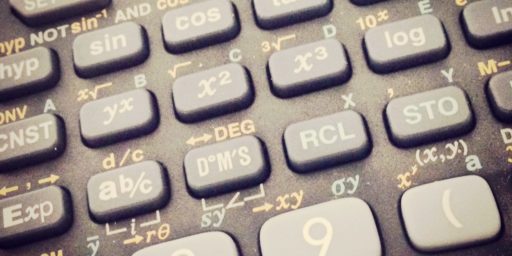The Death of Cursive Writing?
Johnny can't write, either.
Abigail Walthausen reports that many students are no longer being taught cursive handwriting.
The signature, the ability to sign one’s own name with grace and confidence, has long been an essential marker of society. Today more and more I meet high school students who, though they can read, sometimes well and sometimes poorly, are ashamed whenever they are confronted with the need to sign a document. Students are sometimes too embarrassed to admit that they can’t read a piece of an important historical document or the comments of a teacher who writes in script. Script is not seen by students as some quaint relic of the past. Even among kids for whom academic achievement is hardly “cool,” students recognize the pedigree that the knowledge of the cursive alphabet and the ability to write it fluently represent. Cursive has become a status marker.
The mid-sized parochial school where I work provides an interesting view into this phenomenon because the feeder junior highs are so varied. The students who come from the Catholic elementary schools all know script and write it automatically because that is what was required of them. They possess a neater penmanship in both print and script. And as someone who has looked at a great many notebooks, I have observed that they have much greater mastery of the page and they are more astute with the spatial needs of good notetaking. In addition, they do not appear to have sacrificed learning other important skills—they are just as academically competent as their peers and just as likely to know typing.
The students who do not know script come from public schools, most often those designated as “failing.” The Common Core has left the teaching of cursive off the standards, but the trend to pass over penmanship instruction has been building for years.
Cursive was, of course, required when I was in school, starting in very early grades. (I think it was 3rd grade for me, but it may have been 2nd.) My penmanship was quite good because we got so much practice. Alas, because I’ve done virtually all of my writing on a keyboard over the last twenty-odd years, my handwriting is awful. Indeed, if I need to write more than a couple paragraphs by hand, it gets practically illegible. Moreover, when I do write things out these days, I do tend to use print rather than cursive.
If we are thinking about standardized testing, it is important to note that cursive is in fact included in it. On the SAT section for student information, all students are required to copy an oath that they have not cheated, and they must copy it in script. Many students at my school must be instructed to print the sentence first and then connect each letter with their pens.
Well, that’s just stupid. Do we really think students are less likely to cheat if they write the oath in cursive rather than print? Or simply sign a pre-typed oath?
The results look even more terrible than those who struggle through the best pigeon script they know. Now, of course, the students are not graded for the look of their writing, but the ordeal is a terrible note on which to begin a high-stakes test. It sets kids unjustly up for failure to force them to try on illiteracy just moments before beginning a test that is notoriously culturally loaded. Students who struggle through a single sentence feel inadequate. They feel intimidated.
That’s almost certainly horseshit. And, again, the solution isn’t re-introducing cursive to the curriculum but changing the stupid procedure.
It seems like an especially terrible thing to deny kids, because so many enjoy mastering it. Script not only adds speed to writing, but it adds the intimacy of the personal mark to the writing process and adds interest for students who are artistically inclined or visual learners. Edward Tenner argues that it aids cognitive development and builds character. One of my ninth graders, a very weak student who lacks confidence in all facets of communication, written and spoken, but he is also one of the most careful printers I have ever seen. His letters are embellished with delicate curls. He never learned cursive, but I am sure that would have been a great, confidence-building opportunity for him.
Actually, the linked studies seem to indicate that training in caligraphy and repetitive writing drills, not cursive per se, is what’s beneficial. And there’s zero evidence that handwriting builds character; rather, there’s some evidence that character traits can be gleaned from analysis of handwriting.
Most of the defense of cursive is sentimentalism along the lines of this July 2011 WSJ piece by Theodore Dalymple referenced in one of the Tenner essays:
The schoolchildren of Indiana—and those of an increasing number of other states—will therefore never know the joys of penmanship that I experienced as a child. In those days, we still had little porcelain inkwells in the tops of our desks. The watery blue ink eventually evaporated to a deep blue gritty residue, and we used scratchy dip-pens with wooden handles, whose nibs were forever bending and breaking.
Our whole world was inky. Our desktops were soaked in ink; it got into our skin, under our nails and into our clothes. We even began to smell of it. For those of us who were even slightly academically inclined, the callus that formed on the skin of the side of the middle finger as it rubbed against the wood of the pen was a matter of pride: We measured our diligence by the thickness of the callus and longed for it to grow bigger.
Ah, yes, the joys of the ink-stained wretch. And, yes, the middle finger of my right hand is still slightly deformed from all those years of handwriting; the callus is long gone but there’s a decided curvature to the right.
Indeed, the only practical rationale being advanced is Waldhausen’s lament that students who don’t learn to write cursive likely won’t be able to read it, either. I’m not sure that’s of tremendous concern for most people, but it certainly makes archival work—including such things as looking through old family diaries and the like—much more difficult. I’m not persuaded, however, that that’s enough to justify the massive curriculum time required to teach and master.







I have not used cursive since I was in College over 45 years ago, I print. I can still read it most of the time although it is a task sometimes. My signature is an illegible scrawl but it’s been my observation that nearly everyone else has the same problem. In this age of keyboarding cursive does seem anachronistic. Should students be taught to read it? Yes! Should they be taught to do it? I think there are better things to concentrate on.
Part of my line of work is decyphering the cursive of Doctors. They live down to the stereotype. Keyboarding is a massive improvement and they are being forced into it by the ACA, incidentally, because of the requirement to have electronic medical records.
Taking the thought to a somewhat higher level, wouldn’t it be interesting to do some sort of accounting in terms of dollars, man-hours lost productivity or whatever for the misunderstandings that illegible cursive has caused?
Keyboarding also bares the difference between inadvertent lapses of penmanship or composition and real mental and intellectual failures that lead to inarticulateness.
Dr. Joyner, I took the SAT about ten years ago, and I still recall to this day how the cursive writing of the oath was the hardest part of the whole damn test.
I wouldn’t say I felt intimidated or inadequate. I recall the string of muttered curses under my breath as my hand slowly died. I learned cursive in second grade and promptly never used it again. My signature to this day looks like a slightly more-refined Jack Lew copy.
About 10 years ago I had a discussion with older relatives about “the Palmer Method” of cursive writing. They basically spent third grad emaking concentric circles. Their handwriting is beautiful – AND – their printing has draftsman-like qualities. It is more than just legible, they can use their hands to draw straight lines, or curves, or whatever. .
Today: Click point A, click pt B, insert line between.
i moved away from cursive in college at the insistence of one of my professors. My handwriting was so bad, I was told I had to print or type my blue books. Fortunately, in the classes I took that mattered, we wrote in math.
I do wonder if there is some memory value in writing in cursive as it engages the right brain in the process. I do remember, but didn’t save the link apparently, advice on retention discussing the value of writing the information by hand. I don’t remember cursive was separated out. That would be an interesting investigation, any differences in retention of something written in cursive, printed and typed. But then it would only be of great value in copying your notes and such.
@JKB: Many years ago, my daughter was having trouble learning her vocabulary words. Her tutor had her write each word and definition five times claiming it increased retention. He had some material referencing some studies on this and if I recall correctly, it did show cursive worked better for retention. Like I said, this was many years ago and may have been debunked since then.
@JKB: I always thought the big appeal of cursive was, if done legibly, you could write with greater speed.
Well, ask the Internet and it will provide.
Here’s a senior thesis study that found typing notes led to higher retention compared to handwriting:
There’s lots of other links that promote the opposite.
It seems that the typing of lecture notes is due to the higher transcription rate. Whereas, copying by hand engages thinking. But of course, if we taught better note taking instead of rote transcription, we might see the handwriting move ahead.
@Tillman: Nothing beats the speed of shorthand – talk about your dying talents. My sister still writes everything in it – no one can decipher anything of hers.
Tillman has the conventional wisdom on the utility of cursive–it was considered more productive because you didn’t lift your hand off the paper as you wrote the lettersm and, indeed, most people can write in cursive more quickly than they can in print,
Ironically, it was the difficulty of deciphering the stylized results of cursive that caused most businesses to include the instructions ‘PLEASE PRINT” on employment applications, credit applications, and other business related materials.
My own experience with cursive is unfortunate. The tremor (some of my nursing students in the past would ask how long ago I’d been diagnosed with MS–sometimes Parkinsons–as they would watch me fill out forms on the first day) that I have always had interfered with my mastering cursive to the degree that I would have liked to. Same thing happened with piano and touch typing–“manual dexterity” is not my middle name.
The issue of student self-esteem can best be solved–at least in my opinion–by stopping the treatment of poor/public school educated/minority/fill-in-the-blank students as idiots who have escaped their villages. The teachers’ not particularly well-disguised perceptions of the students have more effect than these teachers give themselves credit for.
My penmanship isn’t particularly nice to look at, but cursive is absolutely much much faster than writing in print.
I went to law school a decade ago, and we were still required to write out all of our essays in blue books, no computers allowed. I found that if I tried to print, there was no way in hell I was going to finish the essay in time. Cursive was required simply for the speed.
My “handwriting” has become a cursive/printing hybrid over the years. My signature is a mess unless I want to be sure it can be deciphered, and then it looks like a fifth-graders. Which is probably when I stopped caring.
That is exactly my case as well. I learned penmanship in France using a fountain pen and inkwell. It was beautiful. Now it’s hieroglyphs.
Taking German in High School, I also learned some German cursive. Simply put, it isn’t like American cursive (and I can barely read it). But I sometimes write notes to myself in this “code” (the “a” looks like “ai., “e” looks like “n” – or “r”).
i never has great cursive, now i can barely read it- my own. the dumbing down of society at the school level just gets worse- hopefully it’ll turn around.
It does escape me how the abandonment of an archaic skill (which I personally learned perfectly well but have not used since university days) is ‘dumbing down’ of anything. That’s pure mindless bollocks.
This has been an on going issue for at least fifteen or so years. It comes up every now and then. Some schools still take a stab at this if they have time. Todays schools are driven by the standardized multiple choice tests. Grammar and spelling are also given little attention. Everything in the public schools is determined by politics, which means money. State contractors make huge amounts of money from the testing program. Companies on the state contract list seem to always be ran by the governor’s or legislators’ relatives. Teachers are told “If it is not on the test, don’t teach it”.
I’ve always had terrible penmanship and tend to print. Much rather use the keyboard. In fact, I consider my typing class in 9th grade the most useful course I’ve had. Penmanship can go by the wayside, if you ask me.
The more interesting question is the impact of keyboarding and word processing on the writing process. Back when I wrote or typed essays, the process of writing paragraphs and essays was much more thought out using detail outlines, etc because you couldn’t easily go back and move your thoughts around. Today, I’m just like my kids. I just jump in and start writing, fixing and arranging as I go. I think it has an impact on the thinking and analysis aspect of writing. I think I process thoughts differently than I once did. Haven’t seen any studies on that though.
@beth: Ha! My roommate from college takes down all her notes in shorthand, even at high level pompous meetings. They remain only read by her, for obvious reasons.
It would be interesting to do a shorthand/retention vs. typing/retention test. I switched over to typing my notes in law school because otherwise I kept getting writer’s cramp. (Still had to write out my answers for my Torts exam in longhand because my computer died at the very beginning. A bloody 4 hour exam….)
I also wonder how many of present-day students use the hunt-and-peck method for typing vs. touch typing.
@michael reynolds: Comrade! I spent a year in France when I was ten and got taught penmanship via the mechanical quill pen and the inkwell. I still somewhere have the cahiers I wrote out all the practices in. I seem to remember it was twice a week for a hour.
Over the years my handwriting has been nudged more towards the italic. If I’m writing for someone else, it’s readable. If I’m writing for myself, it’s a scrawl that I have fun deciphering. C’est la vie…
If you’ve got a hankering to mess around with ink and writing implements, I highly suggest learning how to write Chinese characters and controlling the brush. Much more useful.
My primary schoolage daughter loves practicing cursive on our whiteboard easel (best childhood ‘toy’ ever).
My own cursive is more like awful cuneiform – but if I take my time, it’s actually very good. It’s the time factor, more than anything else, imho.
A good analogy to this would be dining (not “eating”).
I changed schools during second grade and had to quickly get on the cursive bandwagon. The school taught the Palmer Method and it was taught rigorously, by the Srs. of St. Joseph. It sucked that I was the only left-handed kid in the school — the nun who tried to force me to become right-handed got slapped down pretty quickly by my parents — and it was a real effort to do it right.
I managed to get my ‘Penmanship Certificate’ in fifth grade and, luckily, changed schools again the next year. it wasn’t until HS, though, when I took a typing course in my sophomore year, that I was liberated… 125 wpm was like growing wings!
If I now must taken handwritten notes, they’re in print. More often, I’m pecking them out on my phone’s virtual keyboard.
My handwriting is so bad that I generally fall back on block characters (all capitals, just taller and shorter). However, I think there is something important about being able to read different handwritten styles (I’ve re-learned this lesson as I struggle to teach myself Japanese – sometimes I don’t recognize the way the natives write certain kana.)
@John Burgess:
My understanding is that you may have gone to school a while ago (no offense), but apparently this is still a real phenomenon. Now, it is usually Asian immigrant parents telling the teacher to make their kid right-handed.
@Scott:
I hear that.
“The schoolchildren of Indiana—and those of an increasing number of other states—will therefore never know the joys of penmanship that I experienced as a child.”
I had plenty of handwriting in school and my penmanship always sucked, so I do not recall the “joys of penmanship”–indeed, my first bad grade was in handwriting.
I have predominantly used printing for decades–not that my printing is all that legible, either.
Beyond personal experience, it seems to me that the time spent on teaching cursive could easily be better applied to any number of subjects.
And I agree with @Lounsbury:
Sounds like they are ascribing cursive writing with all the attributes of yoga. Healthy body, healthy mind.
Yoga probably wins.
@john personna: If they’d really want to do a two-fer they’d be making it a Latin class at the same time. Practice the declensions while writing your letters!
Or copying out Caesar: “Gallia in tres partes devisa est….”
I’d have to say that if they want to teach the “joy of” anything similar to cursive, it would be to bring back pen and paper drafting. At least that teaches kids to visualize in 3 dimensions, use ratios as well as fractions. And requires a very strict adherence to precision and accuracy.
@grumpy realist: Note, of course, that typing notes is only an option in courses where diagrams are not important. So fully typing notes does not apply in, e.g., science, where illustrations are pretty critical to understanding and/or applying material.
But, yeah, I’ve been transcribing non-diagrammatic material via computer for about 15 years. There’s no substitute for the speed you can get with it, nor for the ability to immediately send it to lots of people and have it read without problem. Contrast that with quickly-produced diagrams or mechanical sketches that need to be photographed or scanned for transmission; the recipients invariably write back with something along the lines of “was that 19 or 17”?
It is interesting that so many associate note taking with transcription.
Of course, many professors, not to mention meetings, defy finding, much less sorting, the main topics and supporting elements for outlining. It says a lot about education that the confusion still reigns.
James, even when they had time to teach cursive, there were plenty of teachers who gave up on students like myself, and now this southpaw can only write cursive (or print) using the claw method.
I have tried writing using the proper method to hold a pen or pencil, and I feel like I can pull it off for (ridiculously!) brief periods of time, but yeah….my penmanship is horrible, and has been for many years (heck, most of my life).
I am just fortunate a typing class was available to me in Junior High, and by the time I headed to college, using a typewriter/computer was the accepted method of generating a report (it would have killed me if I had to handwrite all my reports, and as an English Major, perhaps I would not have made it as far along as I did…ultimately ended up with a BA from UC Santa Cruz).
I am only 42, so I am bit startled that it has not been all that many years since I was in school, and they are already phasing out teaching critters like myself how to write a note that does not involve a typewriter / computer / smart phone. It sounds like the days of using a blue book to write out a report / answer essay questions are quickly becoming a thing of the past.
JKB touches on a point that is getting overlooked here.
(Disclaimer: I’m old, and I used to do calligraphy for fun.)
With the elimination of art and music curricula everywhere, handwriting was the very last thing being taught to grammar school kids that had any element whatever of manual dexterity training or art. I’m not going to assert without evidence that kids who never have to practice handwriting will turn out to produce fewer surgeons, artists, engravers, jewelers, etc. — but I think it’s possible. Especially now that the OTHER sources of fine-motor skill practice — playing a musical instrument and tinkering with gadgets — are also sharply on the wane.
My mother’s handwriting is so beautiful that it has a nice side effect: her signature (or any other writing) can’t be forged.
Side note: I learned to print in Illinois, and handwriting in Nebraska. My brothers learned both in Maryland, from different teachers in different schools. All of us have handwriting that is recognizably the same, and quite similar to our father’s handwriting. Scary.
@DrDaveT:
Video games, iPhones, keyboards. My 16 year-old’s manual dexterity far surpasses mine and I suspect is superior to that of most members of my generation.
@DrDaveT: The students are getting some practice in manual dexterity: filling in those little bubbles on test answer sheets. It is certainly true about musical instruments. This seems to be a lost art. Try to find a piano teacher. Churches have to scrounge to find pianists and organists.
@michael reynolds:
Actually, I was deliberately contrasting fine-motor activities versus what you get with keyboards and video games. Game controllers, even the kinetic ones, encourage movements that are orders of magnitude less nuanced than those required to play a violin, build a ship in a bottle (or even a basic scale model car/plane/ship), write the half-uncial hand, solder small components, fix a slot car, etc. What game controllers do teach is an acute grasp of complex timing — but that’s a separate topic.
@michael reynolds:
I am getting better at Temple Run, but the kids scoff that it is a very old game. They are so over it.